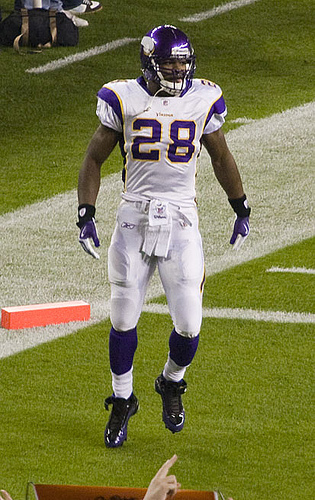
A rare shot in which superhuman Adrian Peterson was caught with his foot on the ground. (Photo by xoque.)
In December, I openly wondered on the blog and in my Footballguys Insider column whether there was something more to Adrian Peterson’s abdominal injury than was being reported.
I’m anxiously awaiting more specifics on Adrian Peterson’s abdominal injury. It’s something he’s played through for multiple weeks now, which usually hints at an injury that is not significant. However, there are relatively few injuries involving the abdominal area and some of them – abdominal muscle tears (a.k.a. sports hernia), oblique muscle strains, among others – are very difficult to play with effectively. If Peterson breaks the rushing record and takes his team to the playoffs while playing through one of those injuries, it’s another story to add to his legend.
Today, the Vikings announced that Peterson recently underwent surgery to repair an abdominal muscle tear, an injury often reported as a “sports hernia.”
Peterson’s abdominal issues were first reported in mid-December. Over the final four weeks of his season, including the last three weeks of the regular season and the Vikings’ playoff game, Peterson carried the ball 104 times for 596 yards, a 5.7 ypc average.
(Edit: Peterson told ESPN’s Josina Anderson today that he suffered the injury in Week 10. After the Vikings’ Week 11 bye, Peterson ran for 1068 yards on 175 carries. That’s an average of 25 carries per game and 6.1 yards per carry.)
I would argue that’s as impressive as his well-chronicled recovery from the ACL, LCL and meniscus injury he suffered in December, 2011.
Here’s why.
Sports hernia and core abdominal muscle injury are generic terms for many different kinds of abdominal and pelvic injuries. The website of Dr. William Meyers, an expert on these injuries and the surgeon who performed Peterson’s repair, reports as many as 121 combinations of injury to the structures in the region. Many of these injuries are overuse injuries of sorts, and are related to the stress of the repeated, abrupt movements a player makes.
In Peterson’s case, it’s highly likely his injury was related to the sudden, explosive changes of direction he makes while running the football. And it’s almost certain that, after the injury, any of those explosive changes of direction would have caused pain and complicated by some weakness in the muscles and structures that were injured.
(Edit: Anderson’s Q&A with Peterson confirms my speculation. She also reports that Peterson had a cortisone shot in Week 13.)
Despite the pain and limitations, Peterson gutted out over 25 carries a game for another four weeks (at minimum) and nearly broke the single season rushing record. Though it’s important to note again that no two core abdominal injuries are alike, most other NFL athletes would’ve elected to have surgery much earlier in the process. Greg Jennings missed a month with a similar injury this past season and Peterson’s teammate Geoff Schwartz could only make it “three days in camp with that injury before I needed surgery.”
Peterson’s return to elite play is freakishly impressive.
The elephant in the locker room, of course, is whether Adrian Peterson’s superhuman season was assisted by performance enhancing drugs. I’m not aware of a PED that would counter the pain and weakness caused by a torn abdominal muscle, so I think it’s less relevant to this discussion than his recovery from reconstructive knee surgery.
Meyers’ website reports that most of his surgical patients return to their prior activity levels in 3-8 weeks. That’s consistent with what we’ve seen from his NFL patients.
Expect to see Peterson ready to further advance his legend well in advance of training camp.
Categories: Injury Updates
 14 Players at Risk of a Medical Red Flag on Draft Day
14 Players at Risk of a Medical Red Flag on Draft Day  More Surgery Necessary For Rob Gronkowski?
More Surgery Necessary For Rob Gronkowski?  Rob Gronkowski: Three Surgeries, One Impressive Scar
Rob Gronkowski: Three Surgeries, One Impressive Scar  Star Lotulelei: Why His Pro Day Workout May Be Irrelevant
Star Lotulelei: Why His Pro Day Workout May Be Irrelevant
Leave a comment